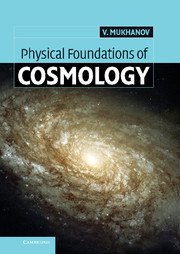Foreword by Professor Andrei Linde
Published online by Cambridge University Press: 05 September 2012
Summary
Since the beginning of the 1970s, we have witnessed spectacular progress in the development of cosmology, which started with a breakthrough in the theoretical understanding of the physical processes in the early universe and culminated in a series of observational discoveries. The time is ripe for a textbook which summarizes the new knowledge in a rigorous and yet accessible form.
The beginning of the new era in theoretical cosmology can be associated with the development of the gauge theories of weak, electromagnetic and strong interactions. Until that time, we had no idea of properties of matter at densities much greater than nuclear density ∼ 1014 g/cm3, and everybody thought that the main thing we need to know about the early universe is the equation of state of superdense matter. In the beginning of the 1970s we learned that not only the size and the temperature of our universe, but also the properties of elementary particles in the early universe were quite different from what we see now. According to the theory of the cosmological phase transitions, during the first 10−10 seconds after the big bang there was not much difference between weak and electromagnetic interactions. The discovery of the asymptotic freedom for the first time allowed us to investigate the properties of matter even closer to the big bang, at densities almost 80 orders of magnitude higher than the nuclear density.
- Type
- Chapter
- Information
- Physical Foundations of Cosmology , pp. xi - xiiiPublisher: Cambridge University PressPrint publication year: 2005
- 1
- Cited by

